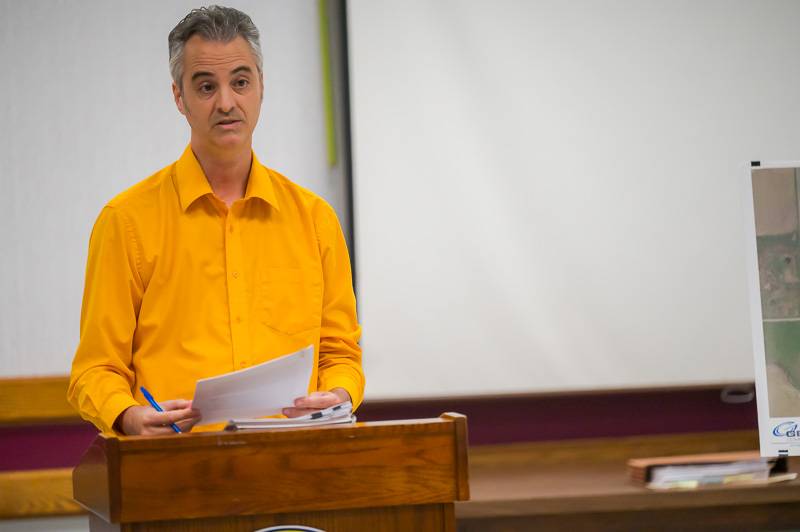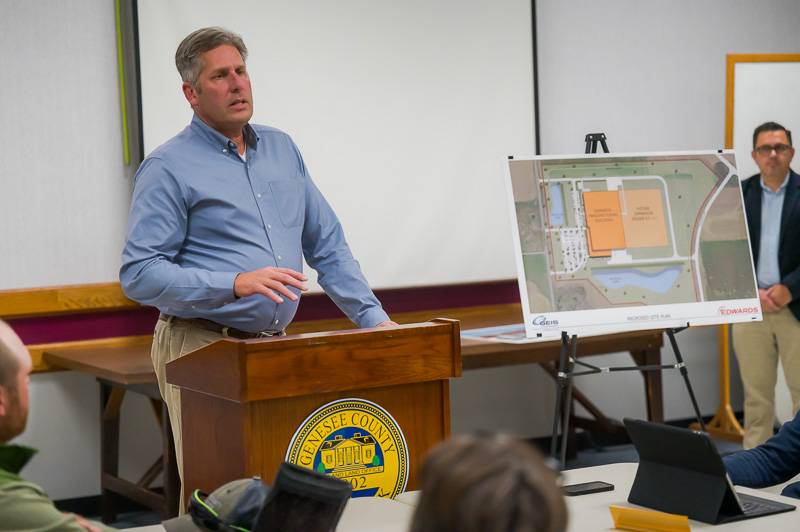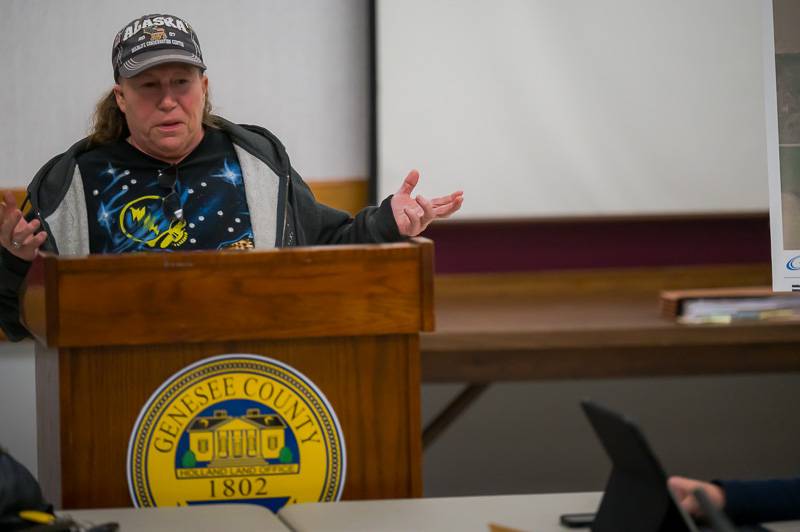
Photo by Howard Owens.
CLARIFICATION: Dr. Kirk Scirto informed us on Oct. 18 that he did not say that he represented the Seneca Nation.
It's unusual for opponents of a development project to speak at Genesee County Planning Board meetings, but two people opposed the proposed Edwards Vaccum plant at WNY STAMP and of the STAMP project itself were at Thursday's meeting.
Both spoke after a representative of Edwards made his presentation to the board and after the board voted to recommend approval of the site plan review and final subdivision.
Both speakers raised a number of environmental concerns, all of which were later refuted in interviews after the meeting by representatives of Edwards and the Genesee County Economic Development Center.
Edwards is proposing a manufacturing facility that will be 236,000 square feet and sit on a 50-acre parcel. The company is a subsidiary of Atlas Copco Group and is planning a $319 plant that will build a semiconductor dry pump, a necessary component in maintaining cleanrooms for companies that make computer chips.
Dr. Kirk Scirto, a family physician in Akron, said he represented the Seneca Nation as well as a coalition of environment groups and as many as 500 residents who oppose both the Edwards Vacuum project as well as STAMP.
"I urge you strongly to recommend disapproval of the Edwards vacuum project," Scirto said. "Know that Tonawanda Seneca Nation lies at the border, immediately at the border of STAMP. They have sued to block its development along with a separate suit to do the same by the Orleans County Legislature. And now the town of Shelby has joined us in the suit. The community impacts of this project in Genesee County are also very troubling, and it's shocking that entities in Genesee County have not yet sued. Although that should change shortly."
The other opposition speaker was Evelyn Wackett, who admitted that she didn't know anything about WNY STAMP, despite heavy coverage of the high-tech industrial park in local and regional news outlets for more than 13 years, until this past Arbor Day. Wackett, a resident of Buffalo, said she is a licensed wildlife rehabbed in Erie County.
"As I looked into it and learned about it, I kind of started getting a little bit upset," Wackett said. "It seems to me a little fishy the way things are going on with this whole project. We come out of the COVID lockdowns, and all of a sudden, Plug Power is there. And now Edwards is coming in."
Vehicle Traffic
Scirto's first objection was to traffic in and out of the Edwards site, both for the additional traffic on local roads and emissions.
"The Edwards Vacuum project would be an immense generation of traffic, according to the February 2023 SEQR that was written by the Genesee EDC," Scirto said. "We've heard some different estimations today, so I'm a bit confused about that. According to GCEDC, vehicles would be expected to enter the leave STAMP every one to two seconds all day every day. This would dramatically slow down local routes, including routes 77 and 63, which may be forced to become 30-mile-per-hour roads."
It's not clear where he got the speed-limit change data.
"Air pollution would be a second major impact, and it will be produced by diesel trucks and other vehicles, and in the chemical emissions of Edwards vacuum itself," Scirto said.
Mark Masse, senior VP for operations for GCEDC, suggested Scirto is misreading the SEQR (an environmental review document) that included the WNY STAMP infrastructure projects and both Edwards Vacuum and a parallel warehousing development that hasn't been discussed much publicly. In the SEQR report, nearly all of the contemplated traffic, Masse indicated, could be attributed to the warehouse project.
The estimated one or two truck trips per day for STAMP, as discussed by David Ciurzynski, a local consultant representing Edwards Vacuum in the meeting, is accurate, Masse said.
"It (the SEQR) was about a 23-page resolution," Masse said. "I'm sure if somebody was unaware of what they were looking at, it would be easy for them to get confused."
Toxins and Chemicals
"If they're able to dodge the extensive lawsuits already initiated and those which will be coming shortly, then they will be allowed to emit various toxins into the air," Scirto said. "Some of these toxins can cause cancer and irritate the eyes in the respiratory tract of people. This, combined with air pollution, would cause or worsen asthma, allergies, emphysema, respiratory infections, and heart disease, especially for those living closest to the factory and its intense traffic."
He said documents on the company website reveal that Edwards Vacuum uses chemicals and fibers that are dangerous to human health.
Ciurzynski said that Scirto is using outdated documents and documents not relevant to this project to make his claims. He said Edwards makes a wide range of products that are referenced in publically available documents, but the company is making a very specific pump in the facility. There is no foundry, and nothing dangerous will be emitted from the factory, so much of what Scirto referenced is irrelevant.
"We're not releasing any toxins," Ciurzynski said. "Our process -- we're not releasing anything. Air permits will be issued by the DEC. They're required because every building has exhaust, so we have to get permits from the DEC. They are going to be approved by the DEC to all be basically zero emissions. We're not releasing anything into the sewers other than toilets and sinks and things like that. So it's human waste, you know, from people working in our plant. Our process water, any wastewater that we have (from manufacturing), is getting toted off-site. Everything that we're doing is intentional to minimize the effect on our community and our systems. We're not, we don't want to tax any part of the community. We don't want to tax the community. So that's why we made these extra efforts to make sure that those processes are handled properly."
Fire safety
"The protection of community character would be challenged by the threat of explosions from Edwards vacuum," Scirto said. "According to their safety data sheets, they use dozens of flammable and several explosive chemicals."
Ciurzynski said, "We're building a specific pump here. It's not all of Edwards vacuums products. We don't have chemicals that are spontaneously going to combust. Everything is going on is within the regulations of the EPA and the DEC."
Wetlands
Scirto also claimed that Edwards is planning to build on top of environmentally sensitive wetlands and faulted The Batavian for previously reporting otherwise.
The Batavian's prior story was based on official government reports that could have easily been obtained by Scirto prior to the meeting. Both representatives of Edward and GCEDC said both the planning document and The Batavian's story were accurate. There will be no wetlands disturbed by the Edwards facility.
Wackett said, "In the article in The Batavian, I read about the wetlands and not disturbing the wetlands. Well, let me make a comment that we already disturbed the wetlands. How many spills have we had now already trying to construct this sewer pipe? 600 gallons of fracking fluid is now inside the refuge. That endangered bog turtle. That endangered short-eared owls. And all that endangered northern Harrier -- all those species depend on these wetlands. It's a migratory bird route that you guys just decided to, I don't know about you guys (meaning the planning board), but Genesee County Economic Development Center decided to just plop an industrial park right in the middle of the Tonawanda State Wildlife Management Area, the Iroquois National Wildlife Areas, protected area. I don't understand how they can just put a sewer pipeline in the middle of it."
The STAMP project is entirely outside of both protected areas.
Masse said in the hallway as soon as the meeting was over, "To clarify, there are no wetlands being impacted by this project."
Ciurzynski immediately added, "Your story was accurate. Our survey has been registered with the town and this county. To avoid this (wetlands), we didn't buy that land (containing wetlands)."
As for Wackett's claim that GCEDC that "600 gallons of fracking fluid is now inside the refuge," Masse said that statement isn't accurate.
He said during the construction of the wastewater pipeline, a channel is drilled through the subsurface and then filled with what is essentially mud to hold the line's shape while the pipe is slid into place. "
"It's basically water and clay," Masse said. "The soil is so soft that it actually ended up going out through the soil. We've done the appropriate cleanups, we had an approved frac-out plan with the DEC ahead of time as part of our permitting. We are making improvements to it, and all of that cleanup and review is subject to the DEC review."
Asked to clarify what happened, Masse said, "In some cases in the refuge, the ground is so porous that when they put the mud in, it leaks out through the sides. It came up to the surface. And that's what they call a frac-out. But it is nothing more than mud. So we had vac trucks on site and cleaned it up. We have subject to DEC inspection on that and in accordance with our frac-out plan."
He said the frac-out has been cleaned up, and while still subject to a DEC follow-up inspection, Masse indicated the event posed no threat to wildlife.
Owls
"I just need to make the comment for the short-eared owl," Wackett said. "From what I understand and what I've read, that the short-eared owl has already declined in numbers since this project has started."
Masse said GCEDC has followed all DEC guidelines and regulations regarding the short-eared owl and north Harrier.
"Essentially," Masse said, the short-eared owl northern Harrier issue has been resolved as we've received a permit to be able to develop that property. As a part of that, we've created a grassland habitat for those birds as the offset for the impact and taking that property. And that permit was issued, I think, in June or July."
As for Wackett's claim that the owl population has already declined, Masse said there is no evidence of that, and there can't be any definitive evidence because of the migratory habit of the species.
"We've done studies over the years, and those birds are non-geo specific, which means they don't come back to the same location every year," Masse said. "So they could be here one year, they could go somewhere else for six years, they could come back here in year seven. I'm sure statewide studies are being done, but whether those are higher or lower, it's hard to tell."
Lawsuits
At the start of his talk, Scirto said the Seneca Nation had sued to stop the STAMP development. It's unclear if that was a reference to the 2021 lawsuit filed against GCEDC that was later settled or if he believes there is a pending lawsuit. GCEDC officials are unaware of any pending lawsuit filed by the Seneca Nation.
Orleans County has filed a lawsuit in a dispute over the sewer pipeline project that runs north into Orleans County. It's not clear from the language of the suit that the aim is to "stop" STAMP, as Scirto claimed during the meeting. The Town of Shelby recently voted to join the lawsuit, even though Shelby previously approved the pipeline.
Whatever is going on with the lawsuits, Edwards Vacuum is not concerned, Ciurzynski said.
"It doesn't concern us because we do care about the environment," Ciurzynski said. "We care about the local people, the farmers. Something people need to know is Edwards Vacuum and Atlas Copco are really conscientious and intentional about their science-based initiatives to reduce their global footprint, global carbon footprint."
Returning to the issue of emissions raised by Scirto, Ciurzynski indicated Edwards has a plant in Korea doing what the Alabama plant will do, but it is "landlocked." It can expand. The STAMP site gives Edwards room for growth, but it also means its products will no longer be shipped by air cargo to the U.S., which will cut carbon emissions.
"Unfortunately, in building, you're not gonna make everybody happy," Ciurzynski said. "We can't keep everything pristine and green. We're trying to keep more than 60 percent of the site green. We're trying to make the building as green as possible by going all-electric, not having fossil fuels.
As part of the green effort, the site will have walking paths so people can enjoy the green space.
Masse said GCEDC has been complying with environmental regulations throughout the planning and development process.
"We've been working with the DEC, the Army Corps of Engineers, and our permit through the Wildlife Refuge took five years to obtain. There were two public meetings, and public hearings were held, and with that, there was a NEPA process done. We followed all the appropriate regulatory steps through this process to date. We are as transparent, and I think you would admit that we are as transparent and organization as you're going to find. We've done everything out in the open. We've done everything in the public. We've done every approval we need to do, and we continue to, and I don't think people realize how much the regulatory agencies have oversight over all construction, over all of the development. You talk stormwater management to the DEC. You talk about construction safety to the Town of Alabama. Operational-wise, it's the town of Alabama, it's the DEC. So there are enough regulatory agencies where I don't think a company would be able to do some of the things that had been said here today without being found immediately, without having somebody know what's going on. So I don't know if they just don't understand how development works. But the amount of oversight and regulatory oversight that happens in New York State is a lot."
The Seneca Nation
Both Ciurzynski and Masse said Edwards and STAMP want to be good neighbors to the Tonawanda Indian Reservation.
"We do care about Native Americans," Ciurzynski said. "We want them to be part of our facility. We want them to work with us. We want them to work at our facility. We want to provide livelihoods so that they can have generational jobs that they don't have to drive miles to get to. It's right next door. You can have a good job and work with wonderful people in a LEAD-certified building that's as green as possible."
Masse said GCEDC has always been open to working with tribal leaders.
"We've been outreaching with the Nation diligently for at least the last seven years, if not the last 13," Masse said. "They just choose not to participate, which is their right."
Public Awareness
As to the implication raised by Wackett that people have been kept in the dark, Masse noted that GCEDC has hosted a number of well-publicized public meetings and public hearings. There was ample opportunity 13 years ago to raise the objections being raised now.
"There are 60,000 people in Genesee County, and we had two people show up who opposed this and said they said they had 500," Masse said. "In the grand scheme of things, you know, I understand people want to be heard. But the majority of the people here, like the Town of Alabama, spoke 13 years ago. And quite honestly, the time to express your concerns about the project would have been 13 years ago when we were going through the EIS process. I think we held 25 to 30 public meetings. So you know, that process was a public process. And there are a lot of concerns voiced, but at the end of the day, the community overwhelmingly was in favor of it."

Photo by Howard Owens.

Photo by Howard Owens.
